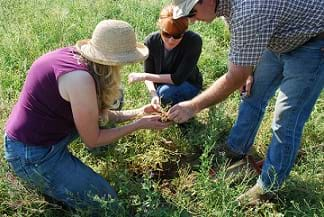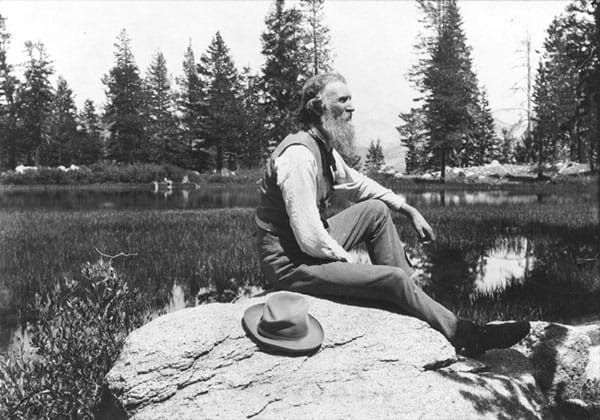Quick Look
Grade Level: 4 (3-5)
Time Required: 30 minutes
Expendable Cost/Group: US $0.00
Group Size: 1
Activity Dependency: None
NGSS Performance Expectations:

| 5-ESS3-1 |
Summary
Students learn the meaning of preservation and conservation and identify themselves and others as preservationists or conservationists in relation to specific environmental issues. They use Venn diagrams to clarify the similarities and differences in viewpoints. They see how an environmental point-of-view affects the approach to an engineering problem.
Engineering Connection
To design solutions for environmental projects or challenges, community teams are often comprised of environmental engineers, conservationists and preservationists. Their challenge is to listen to all viewpoints of an issue (problem, concern, etc.), weigh the pros and cons, consider trade-offs, investigate solutions (or determine no-action is the best scenario) and devise a strategy to implement a decision. Decisions to develop and use technologies must balance environmental and economic concerns. Because of their multidisciplinary knowledge, engineers often play key roles in community decisions that impact the environment.
Learning Objectives
After this activity, students should be able to:
- Understand the definitions of preservation and conservation.
- Identify themselves and others as conservationists or preservationists.
- Compare and contrast different views of people.
- Use Venn diagrams to organize their thoughts on what is different and alike between issues, viewpoints or other things.
Educational Standards
Each TeachEngineering lesson or activity is correlated to one or more K-12 science,
technology, engineering or math (STEM) educational standards.
All 100,000+ K-12 STEM standards covered in TeachEngineering are collected, maintained and packaged by the Achievement Standards Network (ASN),
a project of D2L (www.achievementstandards.org).
In the ASN, standards are hierarchically structured: first by source; e.g., by state; within source by type; e.g., science or mathematics;
within type by subtype, then by grade, etc.
Each TeachEngineering lesson or activity is correlated to one or more K-12 science, technology, engineering or math (STEM) educational standards.
All 100,000+ K-12 STEM standards covered in TeachEngineering are collected, maintained and packaged by the Achievement Standards Network (ASN), a project of D2L (www.achievementstandards.org).
In the ASN, standards are hierarchically structured: first by source; e.g., by state; within source by type; e.g., science or mathematics; within type by subtype, then by grade, etc.
NGSS: Next Generation Science Standards - Science
| NGSS Performance Expectation | ||
|---|---|---|
|
5-ESS3-1. Obtain and combine information about ways individual communities use science ideas to protect the Earth's resources and environment. (Grade 5) Do you agree with this alignment? |
||
| Click to view other curriculum aligned to this Performance Expectation | ||
| This activity focuses on the following Three Dimensional Learning aspects of NGSS: | ||
| Science & Engineering Practices | Disciplinary Core Ideas | Crosscutting Concepts |
| Obtain and combine information from books and/or other reliable media to explain phenomena or solutions to a design problem. Alignment agreement: | Human activities in agriculture, industry, and everyday life have had major effects on the land, vegetation, streams, ocean, air, and even outer space. But individuals and communities are doing things to help protect Earth's resources and environments. Alignment agreement: | A system can be described in terms of its components and their interactions. Alignment agreement: Science findings are limited to questions that can be answered with empirical evidence.Alignment agreement: |
International Technology and Engineering Educators Association - Technology
-
Compare, contrast, and classify collected information in order to identify patterns.
(Grades
3 -
5)
More Details
Do you agree with this alignment?
State Standards
Arizona - Science
-
• Venn diagram
(Grade
4)
More Details
Do you agree with this alignment?
Materials List
- printout of the attached Muir and Pinchot: Respecting Each Other's Differences article
- overhead transparency of the attached Venn Diagram Template
Worksheets and Attachments
Visit [www.teachengineering.org/activities/view/cub_environ_lesson02_activity3] to print or download.Introduction/Motivation
Are you an environmentalist? An environmentalist is a person who cares about the earth and our environment. If so, you may be able to call yourself a preservationist or a conservationist. Have you ever heard the words preserve or conserve? What do they mean?
Well, to preserve something is to keep it protected in its original form or as close as you can to its original form. For instance, say you collect stamps, coins or comic books; you want preserve them—to keep them as new, clean and in as good a shape as you possibly can. A preservationist is an environmentalist who wants to preserve the plants, animals and land as close to their original, natural state as possible.
To conserve something means to use it wisely. Perhaps you have a canteen of water while on a hike with your family. You may conserve the water and only drink a little bit at a time to make sure you have enough for the entire hike. Or, maybe you have only a certain amount of money to use at a game arcade. You may conserve the money to allow you to play games for the entire time you are there, leaving enough money for the bus ride home! A conservationist is an environmentalist who wants to protect the land, plants, water and animals, but also thinks people should be able to use these resources and use them wisely.
Now, do you know which one you are—a preservationist or a conservationist? Today, we are going to read about two famous environmentalists, John Muir and Gifford Pinchot. They both had different views on the environment but often worked together on environmental projects. Maybe their story will help you figure out where you fit in.

Engineers often have to team together with both conservationists and preservationists when trying to design a solution for an environmental problem. Engineers also fall into these two categories, and their view may very likely affect how they approach the solution to an engineering problem.
Procedure
Before the Activity
- Print out the (attached) Muir Pinchot article to read aloud to students.
- Make an overhead copy of the (attached) Venn Diagram Template.
- If you have not already used or discussed the use of Venn diagrams before, you may want to introduce students to how one works before the activity. For a review, see https://thirdspacelearning.com/us/blog/what-is-a-venn-diagram/.
With the Students
- Research the meanings of the words: conserve, preserve, conservationist and preservationist. Assign each term to a team of students, and have them look the term up on the internet or in the dictionary. Have each team report their findings to the rest of the class.
- Suggest a currently "hot" environmental issue or select an issue from one of the previous activities associated with Lesson 2 of the Environment unit or come up with a new one. Ask students to define themselves as either a conservationist or a preservationist in relation to this issue.
- Give students five minutes to think about their own views. Then invite some students to share their ideas and how they view themselves.
- Discuss what key phrases and/or terms help someone identify conservationist and preservationist viewpoints. (For example, preservationists sometimes include the words "preserve, keep the same, preservation, protect, no intrusion, respect, etc." in their speech. Conservationists sometimes include the words "conservation, conserve, use/manage wisely, etc." when they describe their points-of-view.)
- Read aloud the Muir and Pinchot article.
- Discuss what two views the men have in common. What makes them different?
- Display the overhead of the Venn Diagram Template. As a class, make a Venn diagram of the similarities and differences of Muir and Pinchot's views.
- If time permits, make another Venn diagram, this time for conservationists and preservationists in general (or assign this as homework).
- Discuss the possibility of being a preservationist and conservationist at the same time. Is it even possible? (Answer: It is possible to be a preservationist in terms of some issues and a conservationist in terms of others, but it is not possible to have both opinions about the same issue.)
Assessment
Pre-Activity Assessment
Discussion Question: Solicit, integrate and summarize student responses.
- Are you an environmentalist? An environmentalist is a person who cares about the earth and our environment. If so, you may be able to call yourself a preservationist or a conservationist. Have you ever heard the words preserve or conserve? What do they mean?
Research: Investigate lesson topic and summarize findings.
- Investigate the meanings of the words: conserve, preserve, conservationist and preservationist. Assign each term to a team of students, and have them look the term up on the internet or in the dictionary. Have each team report their findings to the rest of the class.
Activity Embedded Assessment
Venn Diagram: Use the attached Venn Diagram Template to investigate similarities and differences between two views of famous environmentalists.
Post-Activity Assessment
Analyzing Articles: Gather pertinent articles, analyze and review as a class.
- Gather some articles that discuss environmental issues. Or, assign the students to bring in environmental articles a few days before the activity.
- Have students review a couple of articles in teams of 2-3. Have them work together to identify whose opinion (conservationist, preservationist, both, other) is presented in each article. Have them think of other opinions related to the issue. What is different about the opinions? Do they have anything in common?
- Have each team present their findings to the rest of the class.
Venn Diagram 2: Use the attached Venn Diagram Template to investigate similarities and differences between other environmental issues or terms. You can also set up the outer circles as "preservationist" and "conservationist" and compare and contrast their different views towards a single environmental issue
- Example topics might include: water pollution, air pollution, deforestation, wetlands, etc.
Troubleshooting Tips
In order for all students to participate in the activity, some may need assistance filling in a Venn diagram.
Activity Extensions
Invite students to attend a school board meeting or other civic meeting. Ask them to identify the members as either conservationists or preservationists.
Have students contact local government officials and survey them about their positions (conservationist or preservationist) regarding different environmental issues.
Visit the following websites for some interesting readings about environmental perspective and philosophy:
- What is Environmental Philosophy? http://pages.hmc.edu/beckman/environment/Phil-140/notes/position.htm
- Environmental Perspective, Los Alamos National Laboratory: https://www.lanl.gov/environment/perspective.php
- Top 5 Environmental Philosophers https://frontier.ac.uk/blog/2018/02/26/top-5-environmental--philosophers
Activity Scaling
For lower grades, a t-chart may work better for talking about similarities and differences of opinions if your students are not accustomed to Venn diagrams.
For upper grades, visit environmental websites such as Greenpeace (http://www.greenpeace.org/usa/en/), the Environmental Defense Fund (http://www.edf.org), etc., for different articles. Have students do their compare/contrast of the online articles. Challenge them to find two articles on the same topic that present opposing views.
Subscribe
Get the inside scoop on all things TeachEngineering such as new site features, curriculum updates, video releases, and more by signing up for our newsletter!More Curriculum Like This

Students recognize environmental opinions and perspective, which will help them define themselves and others as either preservationists or conservationists. Students also learn about the importance of teamwork in engineering.
References
Chandler, Pauline. Environmental Issues (Hand-On Minds-On Science Series): Intermediate, Westminster, California: Teacher Created Materials, Inc., 1994.
Sakamoto Steidl, Kim. Environmental Portraits – People Making a Difference for the Environment, Boulder, CO: Good Apple, Inc., 1993.
Copyright
© 2005 by Regents of the University of Colorado.Contributors
Amy Kolenbrander; Jessica Todd; Malinda Schaefer Zarske; Janet YowellSupporting Program
Integrated Teaching and Learning Program, College of Engineering, University of Colorado BoulderAcknowledgements
The contents of this digital library curriculum were developed under a grant from the Fund for the Improvement of Postsecondary Education (FIPSE), U.S. Department of Education and National Science Foundation GK-12 grant no. 0338326. However, these contents do not necessarily represent the policies of the Department of Education or National Science Foundation, and you should not assume endorsement by the federal government.
Last modified: July 3, 2025







User Comments & Tips